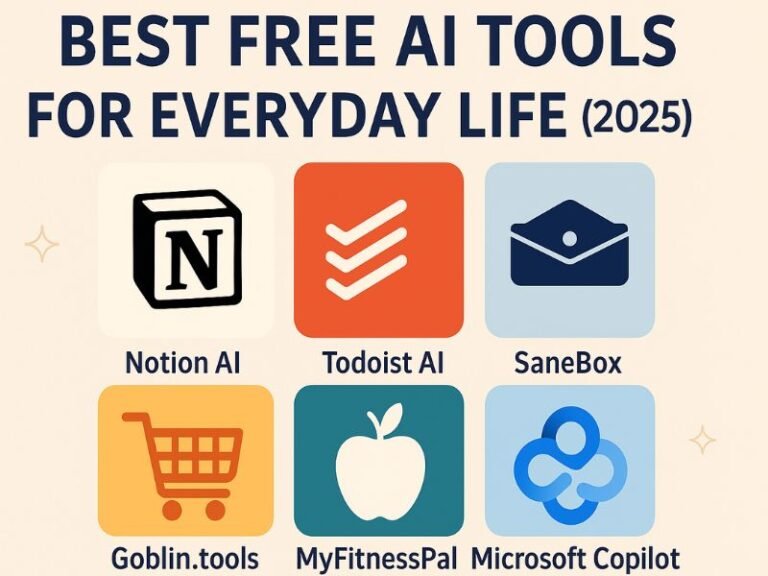Using AI can help you save time by automating repetitive tasks, managing schedules, and organizing your work efficiently. AI productivity tools are designed to handle things like writing, research, meeting summaries, and project planning, freeing you up for more important work. By integrating AI into your daily routine, you can reduce manual effort and accomplish more in less time.

AI time management apps help you track your tasks, prioritize activities, and optimize your workday without overwhelming you. These apps offer features such as reminders, smart scheduling, and progress tracking, which enable you to focus on what matters most. Even if you are new to artificial intelligence, these tools are accessible and simple to use, making the transition smoother.
For beginners, understanding how AI can support your productivity means recognizing which tasks can be automated and how to set up your workflow around these tools. You can start by choosing AI applications that match your specific needs and gradually build your system to save time effectively. This practical approach ensures you use AI for efficiency, not complication.
How to Save Time with AI

Using AI effectively can streamline your workflows, reduce manual effort, and help you focus on high-priority tasks. You can gain measurable improvements in productivity by integrating the right AI tools into your daily routine.
Benefits of AI for Time Management
AI tools help you organize your schedule, prioritize tasks, and reduce decision fatigue. With automated reminders and smart scheduling, you avoid missing deadlines and can allocate your time more efficiently.
AI productivity tools also analyze your habits to suggest optimal work periods. This ensures that you spend less time procrastinating and more on meaningful work. Some apps even automate repetitive communication, freeing up your inbox.
Using AI for time management turns your calendar into a proactive assistant. It adapts to changing priorities and can reschedule appointments or deadlines automatically, helping you stay on track without manual adjustments.
Common Time-Consuming Tasks Automated by AI
Routine tasks such as email sorting, meeting scheduling, and document generation consume hours daily. AI tools automate these processes by categorizing emails, suggesting meeting times, and creating content drafts.
You can delegate data entry and basic research to AI, eliminating repetitive manual work. This boosts productivity by allowing you to focus on analysis and decision-making rather than preparation.
Other automated tasks include tracking project progress and generating reports. By using AI dashboards and analytics, you gain actionable insights faster than compiling data manually.
Example Tasks AI Automates:
- Email filtering and response suggestions
- Calendar and meeting coordination
- Automated writing and content editing
- Data collection and report generation
Overcoming Challenges When Adopting AI Solutions
Adopting AI tools can involve a learning curve and some initial setup time, which may feel like an obstacle. You should start with AI solutions that integrate easily with your current systems to minimize disruptions.
Privacy and data security are essential concerns. Choose AI tools with transparent policies and strong encryption to protect your information.
Resistance to change is another challenge. To overcome it, focus on small wins by optimizing one workflow at a time. This approach helps build trust in AI’s efficiency and encourages gradual adoption.
Training and consistent use are key to maximizing AI productivity benefits. Regularly updating your selected tools ensures you leverage the latest improvements without losing productivity to outdated features.
Essential AI Productivity Tools

Using AI tools can streamline your workload by supporting writing, summarizing, automating tasks, and handling meetings. These tools help reduce manual effort while increasing efficiency in everyday activities.
Top AI Writing Assistants
AI writing assistants like ChatGPT, Notion AI, and Copy.ai help you generate content quickly. Whether you need emails, reports, or creative writing, these tools provide suggestions, correct grammar, and improve clarity.
With natural language processing capabilities, you can draft documents efficiently while maintaining a professional tone. You save time on revisions and brainstorming by letting the AI handle initial drafts or editing.
These assistants integrate well with your workflow, often supporting multiple platforms like Google Docs and Microsoft Word. Some, like Microsoft Copilot, are built directly into widely used software, shortening the learning curve.
AI-Powered Summarization Tools
Summarization tools such as Summari condense long documents and articles into concise, digestible points. This is useful when you need to understand large volumes of information quickly.
You can feed these tools meeting notes, research papers, or lengthy emails, reducing the time spent reading while still capturing key insights. Smart summarizers highlight action items and essential facts.
Many tools support multiple input formats and export options, allowing easy sharing with your team. Summarization improves decision-making speed by keeping relevant data accessible without information overload.
Automating Workflows and Integrations with AI
Automation platforms like Zapier connect your favorite apps and automate repetitive tasks. You can create “zaps” that trigger actions across email, project management, and CRM systems without manual input.
This reduces delays caused by switching between tools or manual data entry. With AI integration, workflows can adapt more intelligently, handling complex sequences faster.
By combining AI with automation, you free up time to focus on higher-value tasks. These tools often include templates for easy setup and support multiple software ecosystems.
AI Meeting Assistants and Transcription Solutions
AI meeting assistants like Otter.ai, Fireflies, and Descript record and transcribe meetings in real-time. They provide searchable transcripts, speaker identification, and keyword highlights.
You won’t miss important points or action items, as these tools capture everything while allowing you to stay engaged in discussion. Some, like Fireflies.ai, integrate with calendars and conferencing platforms for seamless operation.
Transcriptions can be edited, shared, and archived, making follow-ups and collaboration more efficient. These assistants save time on manual note-taking and improve meeting productivity.
How to Use AI to Optimize Your Workflow

AI can help you automate repetitive tasks, organize projects, and communicate more efficiently, saving valuable time each day. By integrating specific AI tools, you can focus on the high-impact parts of your work while routine activities are handled seamlessly.
Streamlining Content Creation Processes
AI tools like Perplexity and AI-driven writing assistants can generate drafts, suggest edits, and assemble research quickly. This helps you avoid starting from scratch and cuts down the time spent on revisions and formatting.
You can use AI to automate content ideas, summarize large datasets for articles, or create visuals without needing advanced design skills. Leveraging AI-powered content generation allows you to maintain productivity even when managing multiple projects.
Using automation platforms like Zapier can connect your content apps, triggering workflows that post updates or organize files automatically. This cuts manual work and keeps your content workflow smooth and efficient.
Improving Task and Project Management
AI productivity tools provide smart scheduling, task prioritization, and deadline reminders. These features help you organize your day and keep projects on track without constant manual updates.
AI-driven project management software can analyze your workflow, identifying bottlenecks and suggesting adjustments. This insight allows you to optimize resource allocation and balance your team’s workload effectively.
You can automate repetitive task assignments and status updates, freeing time for higher-level decisions. Using AI in project management minimizes human error while ensuring you meet key milestones consistently.
Using AI for Communication Efficiency
AI tools can transcribe meetings automatically, summarize conversations, and extract critical action points, so you don’t need to rely solely on note-taking.
Chatbots and AI email assistants can handle routine inquiries and draft responses. This helps you reduce email overload and accelerates internal and external communication.
With AI-powered scheduling assistants, you avoid the back-and-forth of arranging meetings. These tools analyze calendars, suggest optimal times, and send invites automatically, streamlining coordination with your team and clients.
AI Time Management Apps and Solutions

AI time management tools help you organize tasks, prioritize work, and automate scheduling. You can use these apps to reduce manual planning, optimize your calendar, and maintain focus throughout your day.
Features to Look for in AI Time Management Apps
Look for apps with smart task prioritization that automatically ranks your tasks by urgency or importance. Integration with your calendar is essential to sync meetings and deadlines.
Automation features like auto-scheduling help fill available time slots for breaks, habits, or sessions, saving you the hassle of manual adjustments.
Collaboration support is key if you work in teams, enabling shared task lists and progress tracking. Also, consider apps with AI reminders that nudge you gently, not aggressively, to stay on track.
Security and privacy matter, especially if the app accesses your calendar or communication tools.
Popular Apps for Scheduling and Prioritizing Tasks
Motion offers AI-powered prioritization with calendar integration and team features, making it a strong choice for managing dynamic schedules.
Reclaim automates scheduling on Google Calendar and Outlook. It can carve out 40% more free time by balancing meetings, breaks, and daily priorities.
Sunsama encourages daily planning with an AI assistant but lets you control task focus manually, which appeals to users who want more input.
Notion AI enhances task management by combining notes, projects, and AI-generated content within a customizable workspace.
You can also use Fireflies.ai to automate meeting note-taking, reducing time spent on follow-ups and context switching.
Integrating AI Tools with Existing Workflows
Successful integration depends on how well AI tools work with apps you already use. Use Zapier to connect AI productivity apps with calendars, messaging, or project management platforms, enabling seamless automation.
Microsoft Copilot integrates AI directly into Microsoft 365 apps like Outlook and Teams, allowing you to manage emails and schedules without switching tools.
Choose AI tools that support your communication channels and file-sharing systems to avoid disrupting your workflow. Automation should reduce manual inputs, not add complexity.
Regularly review AI recommendations to ensure they align with your priorities and adjust settings to refine task suggestions and notifications.
AI for Beginners: Getting Started Guide

Starting with AI means understanding which tools fit your needs, how to integrate them effectively into your workflow, and being aware of privacy and security concerns. This ensures you maximize productivity while staying safe and confident in your AI use.
Choosing the Right AI Tools for Your Needs
When picking AI productivity tools, focus on what tasks you want to improve. For example, if you need help with writing and organizing ideas, Notion AI is great for note-taking and content generation.
If you work with audio or meetings, Otter.ai offers transcription and keyword extraction, saving hours on manual notes. Look for tools that are user-friendly and offer trial versions.
Check compatibility with your current software and devices. Also, consider the learning curve—choose tools that match your tech comfort level to avoid frustration and speed up adoption.
Tips for a Successful AI Adoption Journey
Start small by integrating AI tools into one part of your routine, such as automating emails or summarizing documents. Set clear, achievable goals for what you want the AI to accomplish.
Train yourself to use AI features gradually, learning shortcuts and capabilities over time. Regularly review results to ensure output meets your expectations and adjust settings as needed.
Keep your workflow flexible. AI is a helper, not a replacement. Don’t rely on it completely—maintain control over critical decisions and edits.
Understanding AI Privacy and Security Basics
AI tools often process your personal or business data, so understanding privacy is essential. Always review the tool’s privacy policy; ensure it encrypts your data both in transit and at rest.
Be cautious with sensitive information. Avoid sharing passwords, financial details, or confidential documents unless the service explicitly guarantees security.
Use strong, unique passwords and enable two-factor authentication where possible. Keep your software updated to protect against vulnerabilities and unauthorized access.



